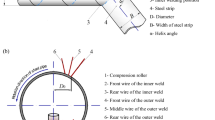Abstract
The combination of collision velocity and angle plays a dominant role for the magnetic pulse welding (MPW) of dissimilar metals. During the MPW process of tubes, the combination depends on the key parameters including radial gap, relative lap length (RLL), and discharge voltage. In this work, the numerical simulations are performed to investigate the effects of RLL on the collision velocity and angle. MPW experiments of 5A02 aluminum tube and SS304 steel tube are conducted, and then, peeling tests and compression shear tests for the joints are carried out respectively to study the influence of these key parameters on the MPW joint quality. The simulation results reveal that the impact velocity declines with the enlargement of RLL but increases with the growth of radial gap and discharge voltage. And the collision angle decreases first sharply and then increases gently with the increase of RLL. And the angle also increases with the increasing radial gap but the discharge voltage seems to be less important. Comprehensively, it is found that there exists an optimum value 7/10 for RLL, 1.75 mm for the radial gap, and 16 kV for the discharge voltage to obtain the joints of good quality in this paper, whose shear strength’s maximum is up to 48.9 MPa. And the relationship between the radial gap and the voltage is found that the smaller the radial gap, the smaller the corresponding proper voltage for a good joint under the same experimental conditions.















Similar content being viewed by others
References
Yu H, Xu Z, Li C, Zhao Z (2011) Experimental study of 3A21 aluminum alloy tube and 20 steel tube by MPW. Acta Metall Sin 47(02):197–202
Liu B, Vivek A, Daehn GS (2017) Joining sheet aluminum AA6061-T4 to cast magnesium AM60B by vaporizing foil actuator welding: input energy, interface, and strength. J Manuf Process 30:75–82
Dietrich D, Nickel D, Krause M, Lampke T, Coleman MP, Randle V (2011) Formation of intermetallic phases in diffusion-welded joints of aluminum and magnesium alloys. J Mater Sci 46(2):357–364
Cui J, Sun T, Geng H, Yuan W, Li G, Xu Z (2018) Effect of surface treatment on the mechanical properties and microstructures. Int J Adv Manuf Technol 98:1081–1092
Kapil A, Sharma A (2015) Magnetic pulse welding: an efficient and environmentally friendly multi-material joining technique. J Clean Prod 100:35–58
Hwang WS (1993) Joining of copper tube to polyurethane tube by electromagnetic pulse forming. J Mater Process Technol 37:83–93
Yu H, Tong Y (2017) Magnetic pulse welding of aluminum to steel using uniform pressure electromagnetic actuator. Int J Adv Manuf Technol 91(5–8):2257–2265
Raoelison R, Buiron N, Rachik M, Haye D, Franz G, Habak M (2013) Magnetic pulse welding: interface of Al/Cu joint and investigation of intermetallic formation effect on the weld features. J Mater Process Technol 213(8):1348–1354
Masumoto I, Tamaki K, Kojima M (1985) Electromagnetic welding of aluminum tube to aluminum or dissimilar metal cores. Transact Japan Weld Soc 2:14–20
Tamaki K, Kojima M (1988) Factors affecting the result of electromagnetic welding of aluminum tube. Transact Japan Weld Soc 19:53–59
Yu H, Xu Z, Fan Z, Zhao Z, Li C (2013) Mechanical property and microstructure of aluminum alloy-steel tubes joint by magnetic pulse welding. Mater Sci Eng A 561:259–265
Ben-Artzy A, Stern A, Frage N, Shribman V, Sadot O (2010) Wave formation mechanism in magnetic pulse welding. Int J Impact Eng 37(4):397–404
Yu H, Dang H, Qiu Y (2017) Interfacial microstructure of stainless steel/aluminum alloy tube lap joints fabricated via magnetic pulse welding. J Mater Process Technol 250:297–303
Deng F, Cao Q, Han X, Liang L (2018) Electromagnetic pulse spot welding of aluminum to stainless steel sheets with a field shaper. Int J Adv Manuf Technol 98:1903–1911
Raoelisona RN, Buirona N, Rachika M, Haye b D, Franzc G (2012) Efficient welding conditions in magnetic pulse welding process. J Manuf Process 14:372–377
Psyk V, Scheffler C, Linnemann M, Landgrebe D (2017) Process analysis for magnetic pulse welding of similar and dissimilar material sheet metal joints. Procedia Eng 207(2017):353–358
Acknowledgments
The authors would like to take this opportunity to express their sincere appreciation.
Funding
This work was financially supported by the National Natural Science Foundation of China (Grant Nos. 51475122 and 51675128) and the National Basic Research Program of China (973 Program) (2011CB012805).
Author information
Authors and Affiliations
Corresponding author
Additional information
Publisher’s note
Springer Nature remains neutral with regard to jurisdictional claims in published maps and institutional affiliations.
Rights and permissions
About this article
Cite this article
Yu, H., Dang, H., Qiu, Y. et al. Effects of key parameters on magnetic pulse welding of 5A02 tube and SS304 tube. Int J Adv Manuf Technol 110, 2529–2540 (2020). https://doi.org/10.1007/s00170-020-06039-6
Received:
Accepted:
Published:
Issue Date:
DOI: https://doi.org/10.1007/s00170-020-06039-6




